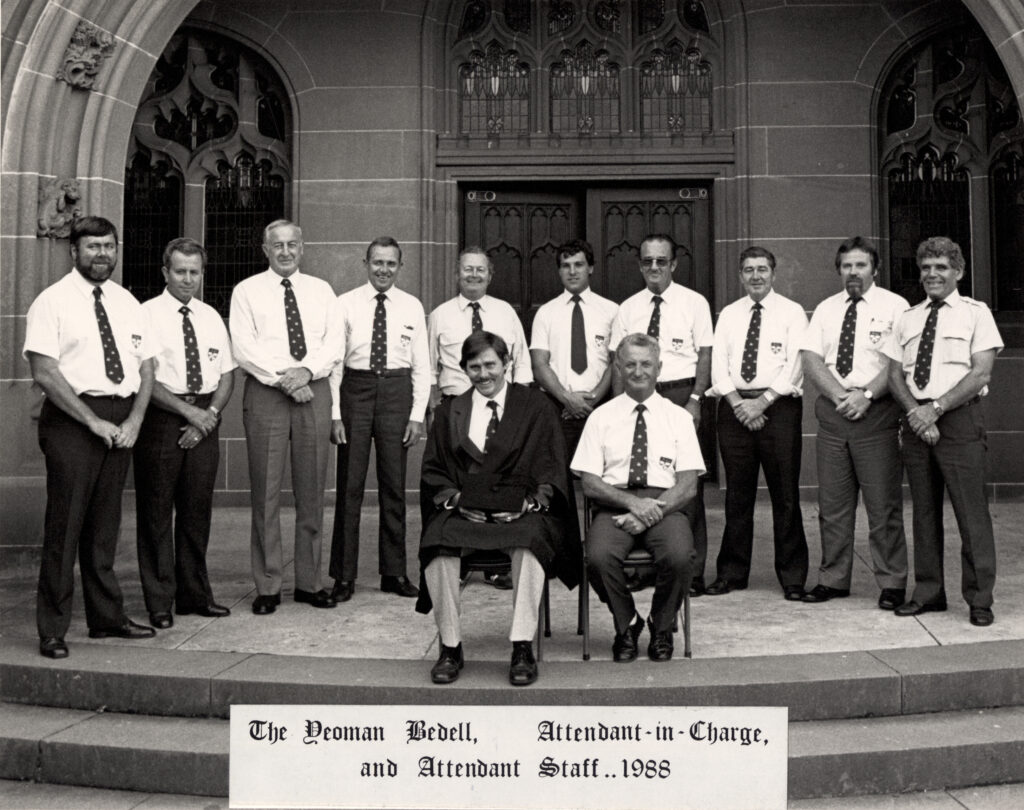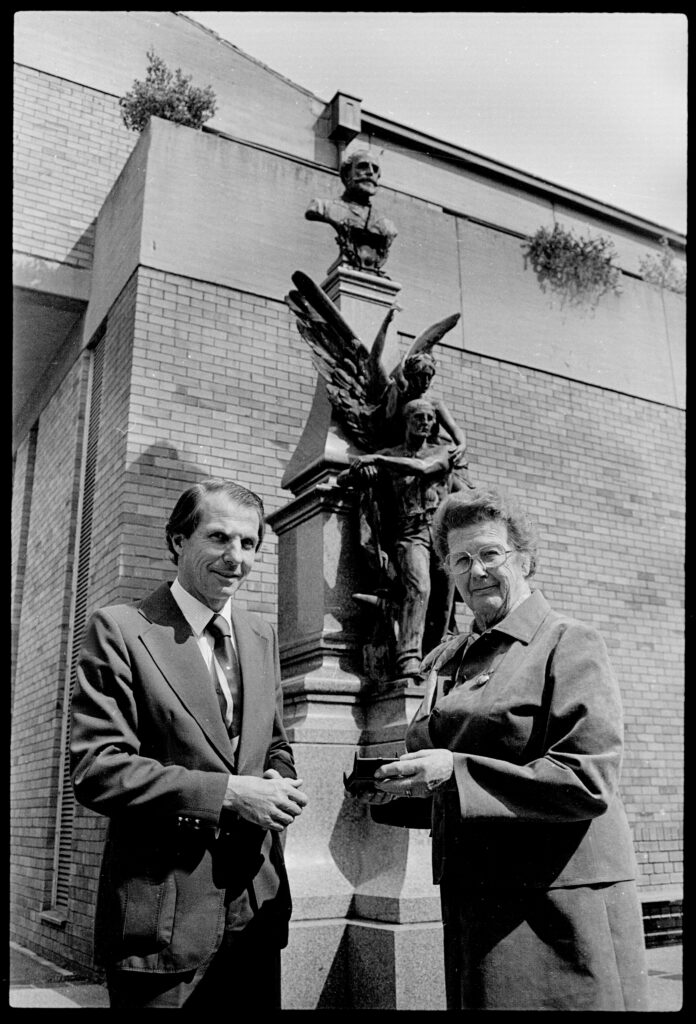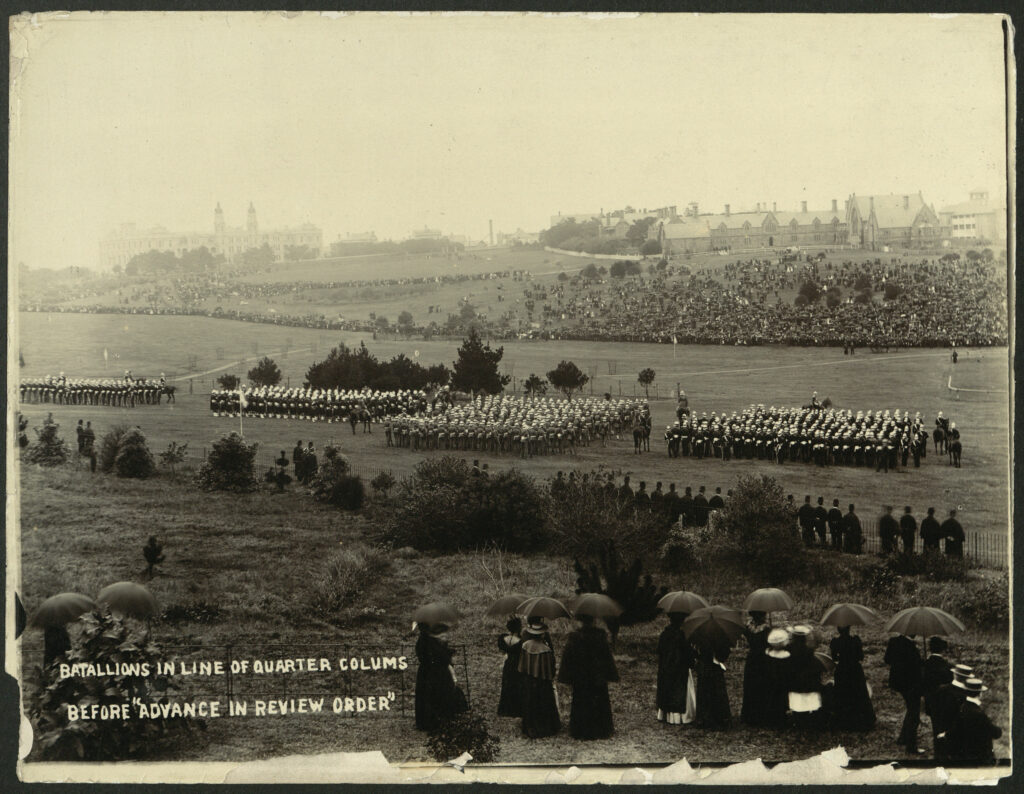The University Archives turns 70 on 3 May this year. To celebrate this milestone, check the blog at the end of each week for the week’s special stories from our collections.

8 April 2024
The Esquire and The Yeoman
On 13 June 1856, Senate approved the appointment of WC Windeyer as Esquire Bedell of the University, a role, which, along with the related Yeoman Bedell, was initially borrowed from the University of Cambridge but continues to be filled to this day. The role, which included having, “…charge of that portion of the Building devoted to the Museum [the Museum of Antiquities], and during the absence of the Curator shall be responsible for the due care of the Collection”, was held by Windeyer until 1866 when he was replaced by John Kinloch. Kinloch served as Esquire Bedell for an impressive thirty years after which, the role was taken over by John Mitchell Purves in 1897.
In 1870, during the Kinloch’s tenure, the role of Yeoman Bedell was created and first filled by Joseph Burrows. The sandstone Gothic revival style building at the Parramatta Road entrance to the University was designed by Professor Leslie Wilkinson and built from 1939 to 1940 as a residence for the Yeoman Bedell. The building was known as the Yeoman Bedell’s Lodge until 1985 when the Buildings and Grounds Committee recommended to Senate that, “…the Gatehouse at the main entrance to the campus be named “Baxter’s Lodge”. George Baxter was the first Yeoman Bedell to occupy the gatehouse when it was built in 1940 and lived there until his retirement in 1956.”.
The position of Esquire Bedell underwent an amendment in 1991, when Senate heard from the Vice-Chancellor that, “The position of Esquire Bedell has remained vacant for some time. The Chancellor and I are in agreement that it would be appropriate if the position were attached to another position in the University, that of President of the Standing Committee of Convocation…Convocation has a particular role to play amongst the graduates of the University, and this would be one way of recognising that role and bringing Convocation into closer contact with the ceremonial aspects of graduations”. Senate accepted the recommendation, noting that, “…the Esquire Bedell would not be expected to attend all graduation ceremonies…On the suggestion of a Fellow, the Vice-Chancellor amended the wording of the proposal to read, and Senate resolved, to invite the holder of the office of President of the Standing Committee of Convocation to be appointed as Esquire Bedell”. This system lasted until 7 March 1994 when Senate heard that, “The Esquire Bedell carries the mace in the academic procession at graduation ceremonies. The President of the Standing Committee of Convocation has requested, as he is unable to attend ceremonies because they fall during working hours, that as a permanent arrangement he nominate a Standing Committee member to act as Esquire Bedell”. The request was approved.
Yeoman Bedell, Attendant In Charge and Attendant Staff (1988), [REF-00003004]. University of Sydney Archives, accessed 08/04/2024, https://archives-search.sydney.edu.au/nodes/view/79718.
9 April 2024
At The Risk of Antagonising Senate
The inaugural meeting of the Society for Free Thought or Freethought was held on 3 September 1930. The Secretary’s Report noted, “That the movement had been greeted with considerable favour was manifested by the large and enthusiastic gathering. Professor Anderson in the chair, explained briefly to the meeting the need for and the projects of the Society. Many social forces and prejudices, he said, were arranged against freedom of thought and freedom of expression. It was the aim of this Society to combat those prejudices”. Professor John Anderson, Challis Professor of Philosophy, was elected President. The Society was open to all members of the University, “…who accept the basis of the Society’s constitution” and presumably, also pay the one shilling subscription fee.
In 1931, the Society was promoted with proclamation that, “The Society “recognizes the primacy of science, holding that in every subject without exception knowledge is to be gained only by observation and experiment, supports the widest possible extension of knowledge on all subjects, and is opposed to every form at censorship and restriction of inquiry.””. The Society did so through its, “Activities: Periodical meetings in the Philosophy Lecture Room; lectures; seven day and evening discussion groups, which meet each week to discuss such questions as religion, Communism, political science, social science (including Eugenics)”.
This commitment to freedom of thought was too much for some, however, as just under a year after the establishment of the Society, on 9 August 1931, the Secretary of the Society wrote in a letter of resignation to Professor Anderson, “I have been requested to forward to Professor Wallace a copy of the resolution carried at the meeting of the Society for Freethought last Thursday. This I am not prepared to do…Of late I have been dissatisfied with the trend of the Society, believing that it affords an opportunity for the dissemination of Communistic propaganda, to which I am strongly opposed. I am not one of those who condemn you for the recent stand you made in the name of Free Speech…I sincerely hope, Sir, that you regain your right to speak as you think fit, but I am not prepared to run the risk of antagonising the Senate for the sake of a society which now lacks my sympathy”. The Committee at its meeting on 11 August 1931, accepted the resignation, noting that it, “…considered the position he [the Secretary] had taken up to be in opposition to Freethought”.
The Secretary of the Society was not the only one concerned, however, as the Chief Secretary’s Department wrote to the Chancellor of the University on 26 October 1932, stating that, “I am directed by the Chief Secretary to transmit herewith for your information, copies of an advising by the Crown Solicitor and a report by a Detective Sergeant – who made certain enquiries – in connection with the publication entitled “Free Thought”.
Society for Free Thought Papers (1930 to 1951), [REF-00089518]. University of Sydney Archives, accessed 09/04/2024, https://archives-search.sydney.edu.au/nodes/view/142376.


10 April 2024
A Munificent Benefactor
In 1908, the sculptor, Bertram MacKennal, was commissioned by Lady Charlotte Russell, wife of Sir Peter Nicol Russell, to create a pair of memorial statues in Sir Russell’s honour. Lady Russell had one installed at the East Finchley Cemetery in London and donated the other to the University. On 10 November 1908, Senate reported that, “A cable was received from Lady Russell through the Agent General concerning her offer of the 15th of January 1906 of Mr Bertram MacKennal’s monument of Sir Peter Nicol Russell. It was resolved that a cable be forwarded accepting Lady Russell’s offer with thanks, and also that the granite base for the monument be prepared under the direction of Mr Bertram MacKennal. The inscription was left to the discretion of the Chancellor”. This memorial monument that today stands outside the Peter Nicol Russell (PNR) Building was first placed on Botany Lawn, beside the Great Hall.
The Buildings and Grounds Committee, on 10 March 1924, noted that, “At the request of the Professors in Engineering, it was resolved that the PN Russell Monument should be erected in the recess at the north eastern corner of the Engineering School”. On 21 July 1924, however, the Committee heard from Professor Leslie Wilkinson who, “…reported that the cost of the removal and re-erection of the Peter Nicol Russell Monument has exceeded the vote of £120 by £18, owing to the pedestal being built with a brick core instead of solidly as was expected. It was decided to recommend that the extra amount be voted”. The matter was ultimately settled in 1925, when the move was approved. The Engineering School was at the time housed in what has since 1975 been known as the John Woolley Building when the Faculty of Engineering was moved to the Darlington area. The April 1970 Gazette reported, “The name of Peter Nicol Russell, for long associated with the old red brick building on the lower side of Science Road opposite the University Union, has now been attached to the Engineering Faculty Building, recently built in the area east of City Road…named the Peter Nicol Russell Building to commemorate still the benefactor whose gifts in 1896 and 1904 totalled £100,000 and made possible the establishment of the School of Engineering”. The inscription affirmed this, “Presented to the University of Sydney by Dame Charlotte Russell in memory of her late husband, Sir Peter Nicol Russell, a munificent benefactor, who endowed the Peter Nicol Russell School of Engineering, June 23, 1907”.
In this image, standing before the memorial statue, is a descendent of Sir Russell, Mrs Earlston Russell, who, to commemorate the centenary of the Faculty of Engineering, was presented with a medal by Dean of the Faculty, Associate Professor John Glastonbury.
Faculty of Engineering Centenary Medal Presentation (1983), [REF-00012925]. University of Sydney Archives, accessed 10/04/2024, https://archives-search.sydney.edu.au/nodes/view/31392.
11 April 2024
The Warmest of Welcomes
On 3 March 1980, the School of Public Health and Tropical Medicine celebrated its 50th anniversary. The occasion, involving a ceremony, special exhibitions and a tour of the building (now the Edward Ford Building), was also used to mark the official renaming of the School to the Commonwealth Institute of Health. On the decision to rename the School, the Convenor of the Inauguration Day Committee, Professor David Ferguson, said, “It used to be a traditional school of tropical diseases but as these were overcome, we have gradually evolved into a public health servicing and training body with a national role in health consultation and education”.
The guests of the anniversary-cross-inauguration were invited to join the Minister for Health, the Hon. MJR MacKellar, as he officially closed the School and opened the Institute. Also in attendance were the NSW Minister for Health, the Commonwealth Director General of Health, the Dean of the Faculty of Medicine and the Principal of the Institute. The 11 March 1980 edition of the University of Sydney News reported on the event, “A hot, humid day prompted the Chancellor, Sir Hermann Black, to extend ‘the warmest of welcomes, both in cordiality and in temperature’ to guests” seating before the building.
In the months prior to the occasion, the University Architect-Planner, MW Jackson corresponded with Deputy Vice-Chancellor, MG Taylor regarding the name change. A key element of this involved updating the front of the building to reflect the new name. It was ultimately decided to etch the new name into the front of the portico, while keeping the original name carved above the main entrance door, however, selecting a font took significant discussion. In a memorandum dated 10 January 1980, Jackson wrote, “The reaction to the proposal that we conveyed to them was that the arrangement outlined on the photograph was a little too squat in the proportions of the letters and that it would be better to consider a more condensed or vertical form of lettering…Alternatively a traditional, formal, classical Roman letterform would be appropriate…it was also agreed that the two dates of the commencement and the change of name would be incised into the existing sandstone above the main entrance door”. In addition to opening the Institute, the Hon. MacKellar was given the honour of unveiling the new name inscribed into the portico above the main entrance.
50th Anniversary Ceremony of the School of Tropical Medicine – Short Video (03/03/1980), [REF-00085518]. University of Sydney Archives, accessed 11/04/2024, https://archives-search.sydney.edu.au/nodes/view/137727.

12 April 2024
British Empire, British Weather
The grey skies nor the rain deterred the New South Wales Military Forces from participating in the annual military review in honour of Queen Victoria’s birthday on 24 May 1895. Despite the poor weather, “The official guests came in their fine carriages”, and with the Military Forces “decked out in colourful uniform”, the “air crackled with the din and was acrid with the pall of smoke from the feu de joie”. The feu de joie, a rapid succession of military gunfire, was held on the grounds near the Royal Prince Alfred Hospital and University colleges, an area of land known as University Park, where buildings such as the Physics Building, the Brennan MacCallum Building and Manning House now stand.
It was in one of his first Senate Meetings as Chancellor that William C Windeyer and other members of the Senate granted permission to Major General Hutton on 6 May 1895 “…to hold the Queen’s Birthday Review of Troops on the University Grounds, subject to the approval of the Colonial Secretary”. Windeyer had long advocated for a volunteer regiment to be formed at the University, and though the idea had been discussed by the Senate multiple times, it never gained traction amongst students. In 1897, Hutton’s successor Major-General George Arthur French suggested to the Senate that a volunteer corps be formed at the University. The matter was then referred to the Professorial Board, who reported in July 1898 that there did “…not appear to be sufficient enthusiasm amongst undergraduates to justify the committee in advising the formation of a Rifle Corps”.
Just two years later, however, sentiments had apparently changed, after Demonstrator in Physics, RC Simpson suggested to Professor of Geology, Professor TWE David that a rifle rorps be established at the University. Simpson’s proposal resonated amongst students, evidenced in the October 1900 edition of Hermes which read, “The great objection which has always been brought forward against the proposal is that the leisure time of the Varsity man is very restricted, and that all of it is already taken up by the demands made on it by the many clubs and societies; that the University sports, in especial, would suffer by this new institution. But as the circulars which have been issued point out, there would be comparatively little encroachment on the Undergraduates’ spare time. One or two drills a week after 5 o’clock, and an occasional Saturday afternoon, would not, we think, be an exhorbitant [sic – exorbitant] tax upon our time, and the advantages to be gained thereby, more than counterbalance the sacrifice required”. The Sydney University Volunteer Rifle Corps was established that year, with 120 members. Numbers steadily increased, with the Corps changing its name to Sydney University Scouts in 1908.
Military Review Celebrating Queen Victoria’s Birthday – Lines of Battalions (25/05/1895), [REF-00088809]. University of Sydney Archives, accessed 12/04/2024, https://archives-search.sydney.edu.au/nodes/view/141615.
Explore the blog for other posts from the University of Sydney Archives and follow us on Instagram.